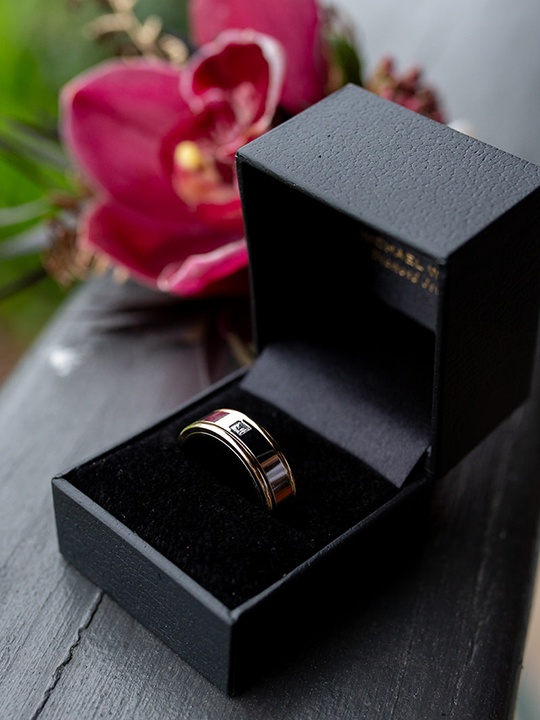Band
As One
As an emblem of love and a symbol of devotion, the noble wedding band has evolved and transformed over the years. To help the modern groom decipher the unconventional and unique wedding band options available, Bethany Hayes chats with director of Creations Jewellery & Designers, Greg Macintyre, and seeks his expertise on choosing an unforgettable wedding band.
Image Credit: Allie Claire Creative
As arguably your longest wearing accessory, it’s important that your wedding band is not only something you love, but something which showcases a design fitting of your personality and preferences; from the subtle and well-loved 6mm white gold band, to an engraved piece with symbolic sentiment. With a multitude of eccentric materials, patterns and ring styles to consider, Western Australia Wedding & Bride guides prospective grooms toward their perfect fit.
There’s Beauty In Simplicity
While wedding band trends for the modern groom are continuously evolving, Macintyre suggests that a large portion of grooms are still opting for a traditional, half-round profile wedding band, in either yellow or white gold. Simple and refined in appearance and smooth to touch, these wedding bands come in a range of finishes including matte, high polish, satin and even sandblasted for long term comfort. While a polished finish will give the band a reflective and shiny appearance, a matte finish has a more lowkey, subtle and smooth finish for grooms who prefer less bling. “Quite a number of grooms don’t want [the ring] to look to shiny and opt for a textured or matte finish,” Macintyre explains.
Having initially pursued a career in engineering, Macintyre’s appreciation and jewellery expertise stems from his thorough understanding of the structure and mechanics required for jewellery making. With this in mind, he advises grooms searching for their wedding band to “consider if [the ring] is suitable to withstand the type of work you do or your lifestyle”. By checking in with experts and making an informed decision regarding the band’s materials, you can ensure your wedding band’s quality and barrier will prevent premature erosion and damage.
For grooms in labour-intense professions, consider choosing a tungsten wedding band. The
durable, scratch-resistant metal offers longevity and strength – a popular option for construction workers, as it can also be easily removed amidst a hands-on building process. A titanium wedding band is another effective band choice for grooms, as the light, hypoallergenic material has three times the strength of steel, while a silicon band is another safe option with its low conductivity and minimal risk of catching on objects. Assisting countless grooms with the search for their wedding bands, Macintyre lists yellow or white gold, platinum, palladium, silver, zirconium or titanium as the most popular material choices, with a trend towards the simple and low-key styles. “Remember in most cases you will have [the ring] for life, so simple, classic designs are good [as] they never date.”
To Wear Or Not To Wear
While not every groom chooses to don a wedding band after getting married, Macintyre suggests that the vast majority of today’s grooms are still choosing to purchase a wedding band to commemorate their marriage, and will either wear the ring consistently, or put it on at the fitting occasion. “I would say that ninety percent still choose to have a wedding band, even if they only wear it occasionally,” he reiterates. Over the past few years Macintyre has noticed an increasing number of grooms leaning towards bolder wedding band designs, such as black zirconium bands or a unique ring combination of zirconium and gold. “I wear one myself and get lots of comments on the ring!” he adds.
If having personalised wedding bands is your preference, consider engraving you and your spouse’s initials, or the date of your wedding on the band for a symbolic and sentimental reminder of your special day. Some partners even choose to have matching wedding bands as a symbol of their commitment to one another, as well as shared values and hopes. For others, cultural heritage can play a role in determining what sort of wedding band is most appropriate. “Grooms from the Nordic countries often require a
matching wedding band to their partners,” Macintyre informs. “We [also] make sygnet rings with a family crest or heritage style bangles, pendants and earrings.”
Diamonds In The Sky
No stranger to working with sparkle, Macintyre says he loves working with diamonds, precious gems and pearls within his jewellery, having even travelled to the world’s diamond capital – Antwerp, Belgium, to source the finest diamonds for his customers. Stepping away from gender normalities, the modern groom can choose to wear any band he so wishes, with expectations surrounding what defines a feminine or masculine wedding band no longer relevant. In-setting a diamond into a ring can be an alluring touch to any wedding band, with diamond’s durability and glamorous sparkle adding flair to the most simple and refined styles of wedding bands.
For grooms looking for something that little bit different, Macintyre suggests black diamonds, which can add a subtle pop of shine to the wedding band, and may feel less intimidating than a lighter, more visible diamond. “Grooms these days are not afraid to add some diamonds, and generally go with the black ones,” he explains. Regardless of taste, preference and even profession, there is a wedding band out there to suit every groom. From subtle diamond insets, to meaningful engravings and unconventional materials, the choice is yours to make.
Having seen countless unique and unusual wedding bands over the years – including a silver skull ring complete with black diamond eyes – Macintyre advises grooms to opt for a quality ring and stay true to themselves and their individual taste. “Jewellery, whether it is a wedding band or another piece can be as individual as you, so take the time to consider what you will be likely to wear not only now, but in years to come.”

